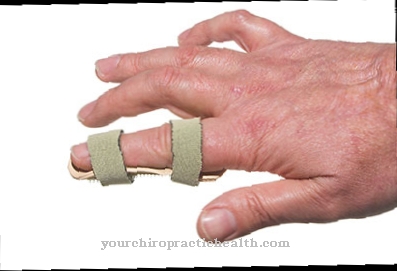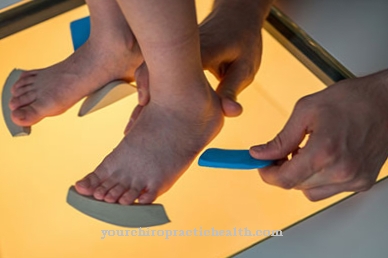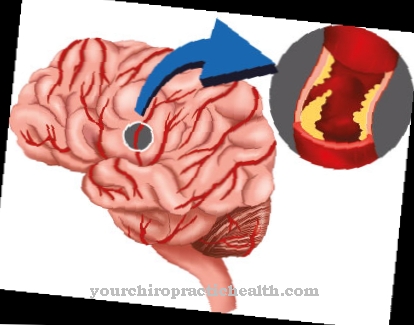A body movement is brought about by targeted or involuntary contraction and subsequent relaxation of muscle fibers. If the function of individual nerves or the entire nervous system is disturbed by diseases or damage, the impulses for triggering the muscle activities can no longer be transmitted correctly. This can lead to a malfunction of individual muscles, with the result that the affected extremities or body parts can no longer be moved or only to a limited extent. In these cases one speaks of a Muscle paralysis.
What is muscle paralysis?

Basically, one can differentiate between voluntary and involuntary movements of the muscles. The movements are controlled via different levels of the central nervous system. Voluntary movements include, for example, consciously and purposefully grasping an object or lifting a foot to climb stairs.
Involuntary movements, on the other hand, happen incidentally and automatically and ensure, for example, that balance is maintained during voluntary movements. If the muscle activity is impaired due to damage, it can lead to slight and temporary paralysis of individual muscles up to massive and permanent failure and paralysis of large parts of the musculoskeletal system.
Sudden paralysis after mechanical damage (e.g. accident or herniated disc) can spontaneously recede or be treated well with a suitable therapy. However, there are also chronic or congenital nerve and muscle diseases that are incurable and can lead to progressive paralysis (e.g. polyneuropathies or muscular dystrophies).
causes
Muscle paralysis can be caused by different factors.
- Mechanical damage: If individual nerves or muscle fibers are damaged or even severed in an accident, this can lead to paralysis. A herniated disc is also a mechanical disorder, which can lead to impairments in the movement.
- Vascular diseases: Smaller cerebral infarctions or cerebral hemorrhages up to strokes can lead to the death of larger areas of nerve cells in the brain. This can manifest itself as a sudden muscle weakness up to temporary or permanent paralysis of one half of the face and body.
- Central nervous system disorders: Multiple sclerosis (MS) or amyotrophic lateral sclerosis (ALS) are just two examples of such diseases. Both lead to progressive damage to nerve cells and permanent paralysis of ever larger muscle areas.
- Bacterial and viral infections: A simple tick bite can transmit dangerous pathogens such as Borrelia and cause inflammation and paralysis in the nervous system. Viruses can also attack the nervous system and cause muscle paralysis, such as the polioviruses in polio.
- Cancers: Tumors in the brain, muscles, bones or the spinal cord can mechanically or biochemically trigger symptoms of paralysis.
- Poisoning: Certain neurotoxins can also inhibit the transmission of impulses between nerves and muscles. These toxins occur naturally, for example as batrachotoxin in the terrible poison dart frog or as botulinum toxin in spoiled canned food.
- Alcohol addiction: ' Long-term high alcohol consumption can lead to toxic damage to nerves and muscles and the associated paralysis.
- Other causes: Psychological factors such as migraines can also trigger symptoms of paralysis.
You can find your medication here
➔ Medicines against muscle paralysisSymptoms, ailments & signs
Muscle paralysis often occurs in the arms and legs (paresis), but can also affect individual skeletal muscles, for example the facial muscles, certain internal organs or the vascular muscles. Signs of muscle paralysis can appear suddenly and without an identifiable cause or creeping, progressive or even in spurts. The beginning of paralysis is often announced or accompanied by tingling, numbness or perception disorders in the affected parts of the body.
Complications
Depending on the type and severity of the paralysis, serious complications can arise that require secondary treatment. Paralysis in the area of the lower extremities is often accompanied by a lack of control over the bladder and bowel, which requires support.
Cognitive disorders in paralyzed extremities can prevent injuries or infections from going unnoticed and can get worse. The most serious complications that can occur as a result of paralysis include breathing and swallowing reflex disorders, such as those that can occur in advanced ALS or paraplegia. In such extreme cases, those affected can only be ventilated and fed externally.
When should you go to the doctor?
Mechanical damage such as bruises, cuts or compression can lead to temporary muscle paralysis. These should usually go away on their own as the injury subsides and do not make a doctor's visit absolutely necessary.
In case of doubt, however, a doctor should always be consulted if the symptoms of paralysis are unclear. Spontaneous muscle paralysis can be the first sign of a serious illness. Especially if there are other abnormalities in the area of the cardiovascular system, language or impaired consciousness, there is an urgent need for clarification by a doctor.
If the signs point to a stroke, the emergency doctor must be notified in any case. Even if symptoms of paralysis occur only temporarily but repeatedly, it is advisable to consult a doctor.
diagnosis
In order to be able to make a reliable diagnosis, those affected are usually first asked thoroughly about symptoms, course, family history and acute symptoms. This is followed by a physical and neurological examination, in which the resulting restriction of movement is assessed.
An accompanying blood test is often also carried out. Depending on the findings, further imaging examination methods may be necessary, for example computed tomography or magnetic resonance imaging of the affected area.
Invasive examination methods such as a brain water test, muscle biopsy or special genetic tests can also be used for clarification. The results then lead to the diagnosis of muscle paralysis and its classification into various forms of paresis (loss of strength or partial paralysis), plegia or paralysis (complete paralysis).
Treatment & Therapy
Analogous to the different causes of muscle paralysis, there are also many different treatment methods and therapeutic approaches. Depending on the type of paralysis, these are used in a targeted manner.
Mild and only partial muscle paralysis with a mechanical cause often heals by itself. Depending on the degree of severity, minor operations may be necessary to restore the severed nerve and muscle connections. In the case of muscle weakness and paralysis due to a stroke, follow-up treatment with targeted physiotherapy is carried out to strengthen and strengthen the paralyzed half of the body. The associated paralysis of the facial muscles often subsides by itself after several weeks.
Bacterial or viral infections, on the other hand, are usually treated with a suitable antibiotic. In the case of Lyme disease, for example, an active ingredient combination must be taken over a period of several weeks at fixed times. The comparatively long duration of treatment is necessary because the bacteria only respond to the antibiotic effect of the medication during their division phases. If treatment is stopped too early, it can relapse.
In the case of tumors, surgery, radiation treatment or chemotherapy can lead to healing.
The treatment of neurological diseases is much more difficult, since the paralysis here is often progressive and irreversible. Often only the side effects can be treated here and the progression of the disease can be delayed as far as possible.
Outlook & forecast
The prognosis and the prospect of complete cure in muscle paralysis must be considered differently due to their diverse causes. In this way, a large part of the paralysis can regress on its own, be successfully treated with suitable therapy, or it can also manifest itself permanently. The prerequisite for this is the timely consultation of a knowledgeable doctor in case of doubt, who will prescribe the appropriate therapy in consultation with the person concerned.
Patients with muscle paralysis are either acutely or permanently in a difficult phase, as the quality of life can be impaired to a greater or lesser extent, depending on the severity of the restricted mobility. In severe cases, the muscle paralysis can lead to immobility or permanent inability to work, which presents the patient with additional psychological difficulties, which can also trigger secondary diseases such as depression or psychosomatic complaints. The prognosis can only be determined in individual cases by talking to the attending physician.
Unfortunately, as the disease progresses, it often happens that the symptoms of paralysis or only the secondary diseases can only be alleviated symptomatically and a further worsening of the symptoms can only be slowed down. In the case of severe manifestations, especially in the case of neurologically-related paralysis, palliative medicine is often the only option to alleviate the patient's suffering and largely support his quality of life within the framework of a severely limited life expectancy.
You can find your medication here
➔ Medicines against muscle paralysisprevention
Prevention is particularly difficult in the case of cancer or neurological or psychological factors that favor muscle paralysis. In general, a healthy lifestyle with sufficient exercise, alcohol and other luxury foods in moderation and a healthy diet is advisable.
Preventive examinations that are offered by health insurance companies and which often include a blood test should be used. Changes in the composition of blood or urine can often be diagnosed and treated at an early stage. In everyday life and during athletic training, attention should be paid to the careful and accident-preventive execution of movements in order to avoid mechanical damage to the muscular and skeletal system.
A particularly high level of hygiene can be helpful against paralysis caused by bacterial infections. Frequent and thorough hand washing often prevents the spread of bacteria and viruses. In order to prevent infection with Borrelia, suitable protective clothing should be worn when spending time outdoors, especially in risk areas, and a tick check should generally be carried out afterwards.
Aftercare
In the case of muscle paralysis, in most cases the patient has very few and only very limited aftercare measures available. The person affected is primarily dependent on a quick and, above all, very early diagnosis in order to alleviate and limit the symptoms. The earlier a doctor is consulted, the better the further course of the disease usually is.
Those affected should therefore ideally consult a doctor at the first signs and symptoms. Most of those affected are dependent on various exercises and on measures of physiotherapy or physiotherapy. These exercises can also be repeated at home in order to permanently alleviate the symptoms. The person concerned should generally avoid heavy physical exertion or stressful activities in order not to strain the body unnecessarily.
Care and support from your own family is also very important in order to limit the symptoms and avoid psychological upsets. When taking medication, the correct dosage and regular intake must always be ensured. A doctor should be consulted if anything is unclear or if there are side effects.
You can do that yourself
In case of doubt or concern, a doctor should always be consulted when muscle paralysis occurs. Even if the treatment turns out to be lengthy in some cases, the therapy should definitely be continued in order to increase the chance of a successful treatment.
If the prognosis is poor and the neurological disease progresses, courage should not be lost.Although there is no therapy available to eliminate the cause of these paralysis symptoms, scientific research in these areas is constantly yielding new treatment methods and, above all, supportive measures that significantly improve the quality of life.
Physiotherapy, massages and occupational therapy measures help to train the muscles, prevent pain and promote the mobility of the affected areas. Participation in self-help groups or psychological counseling can also contribute to increased well-being and acceptance of the changed situation among those affected.



























